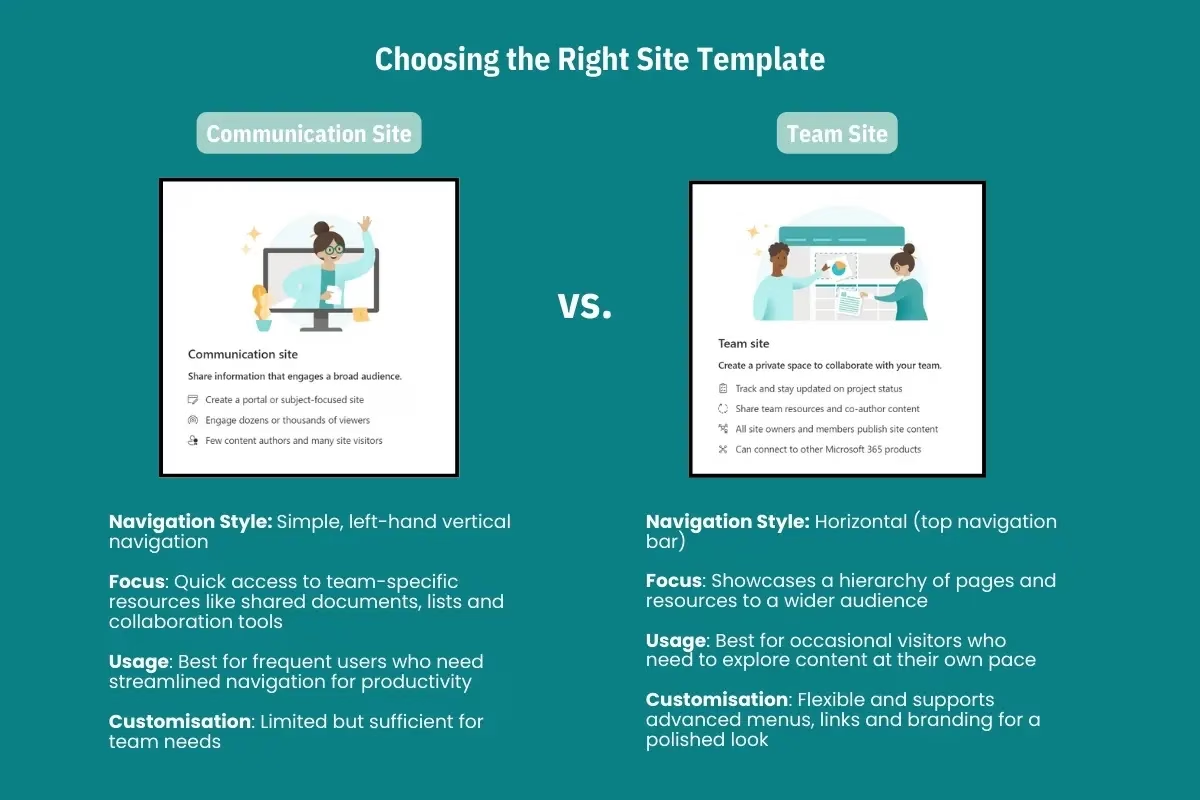
If you are thinking about creating a new SharePoint site but are not sure which type to choose? You’re not alone. As a matter of fact, understanding the difference between Communication Sites and Team Sites is one of the first steps to successful SharePoint planning. When I begin discovery work and delve into the environments of my clients’ SharePoint instances, a recurring theme emerges: the pervasive misuse of the communication site template. I found with my clients that It’s often over-utilised for purposes it wasn’t designed for, which leads to inefficiencies and confusion. To avoid this common pitfall, I’ll walk you through each site type, when to use them, and some best practices to help you plan your SharePoint structure with confidence.
What Are SharePoint Site Types?
When creating a new site in SharePoint Online, two main options are presented:
- Team Site
- Communication Site
Each site type is designed with a different purpose in mind—and choosing the right one from the beginning can make a big difference in how your team collaborates and shares information.
Team Sites: For Collaboration and Daily Work
Team Sites are built for, you guessed it, teams. Think of them as the digital home base for a working group or project team. They’re designed for collaboration, meaning multiple people contribute content, update files, manage tasks, and have ongoing conversations.
Key Features of Team Sites:
- Connected to a Microsoft 365 Group
- Comes with a shared inbox and calendar
- Includes a default document library for file sharing
- Built-in integration with Teams and OneDrive
- Permissions allow edit access for team members
- Left navigation into the libraries and lists that make up your site
When to use a Team Site:
- Managing a project or department
- Collaborating with a defined group of people
- Sharing and editing files regularly
- Storing meeting notes, tasks, and plans
Example: Your Marketing team has a team site where they collaborate on proposals as well as keep all their marketing assets together, they also have a calendar for events as well as all their event planning materials. As this is a site for the Marketing team to collaborate and be the single source of truth of their documents, it is document heavy, so therefore they right choice is to use the team site template.
Communication Sites: For Broadcasting and Sharing
Unlike Team Sites, Communication Sites are for broadcasting information to a wide audience. Think of them as internal websites or digital noticeboards. These are ideal when you want to share content with others rather than co-author it.
Key Features of Communication Sites:
- Typically not connected to a Microsoft 365 Group
- Pages are visually rich and designed to showcase content
- Built for top-down communication
- Default permissions are read-only for most users
When to Use a Communication Site:
- Creating an intranet homepage or department landing page
- Sharing company news, updates, and announcements
- Hosting static content like policies, procedures, or training resources
- Reaching a large group of viewers who don’t need to contribute content
Example: Your company’s internal communications team sets up a site to post news updates, CEO announcements, and highlight upcoming events.
Side-by-Side Comparison
| Feature | Team Site | Communication Site |
|---|---|---|
| Purpose | Collaboration | Broadcasting info |
| Audience | Small, defined group | Broad, larger audience |
| Connected to M365 Group | Yes | No |
| Default Permissions | Edit for members | Read for most users |
| Design Style | Functional, list and library-based | Visual, page-based |
| Use Cases | Project teams, departments | Intranet, news, org-wide resources |

Best Practices for SharePoint Planning
If you’re in charge of setting up sites across your organisation, here are a few things to keep in mind:
1. Define the Purpose First
Start with a clear purpose for each site. Ask: Is this for a group to work together, or to share info with a broad audience?
2. Avoid Mixing Site Types
Don’t try to make a Communication Site do the job of a Team Site (or vice versa). Keep them focused on their strengths.
3. Map Out Your Information Architecture
Plan ahead. Think about site structure, navigation, permissions, and governance. A little planning saves a lot of pain later.
4. Use Hub Sites for Organisation
Group related sites under a Hub Site. For example, all department Communication Sites can be linked under an “Intranet” Hub.
5. Keep Permissions Simple
Team Sites = fewer editors, more contributors
Communication Sites = fewer editors, many readers
Overcomplicating permissions creates confusion (and support tickets).
Final Thoughts
Both Communication Sites and Team Sites are powerful tools—but they’re designed for very different purposes. Understanding when and how to use each one can dramatically improve your SharePoint rollout.
Choose wisely, plan ahead, and remember: a well-structured SharePoint environment is one of the best investments you can make in workplace productivity.



